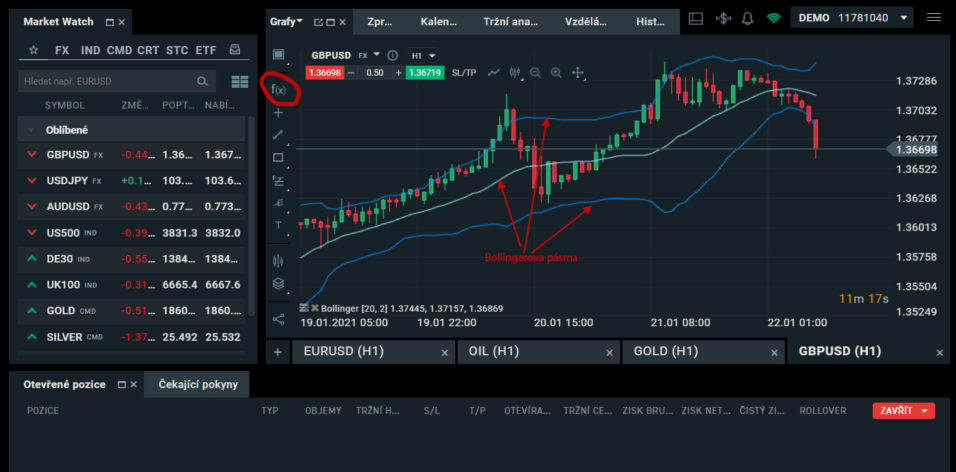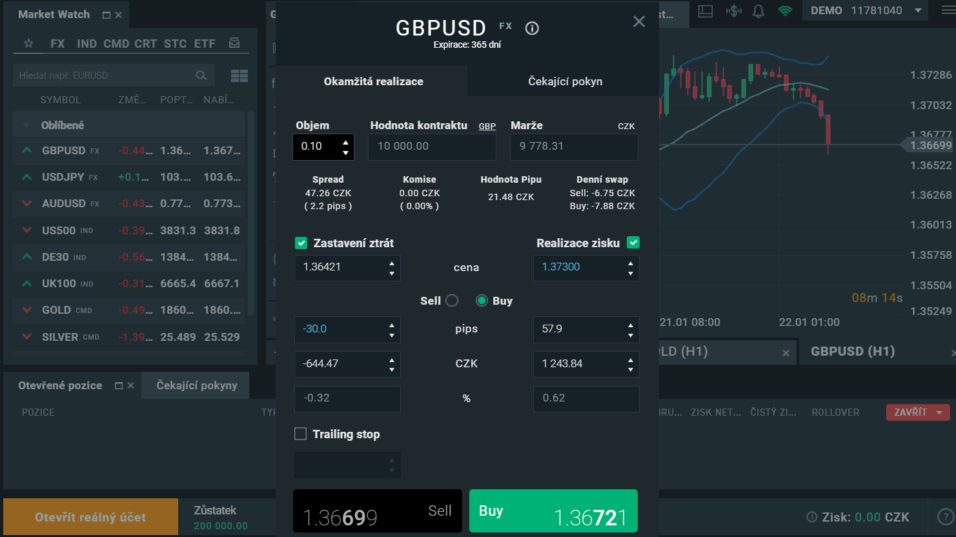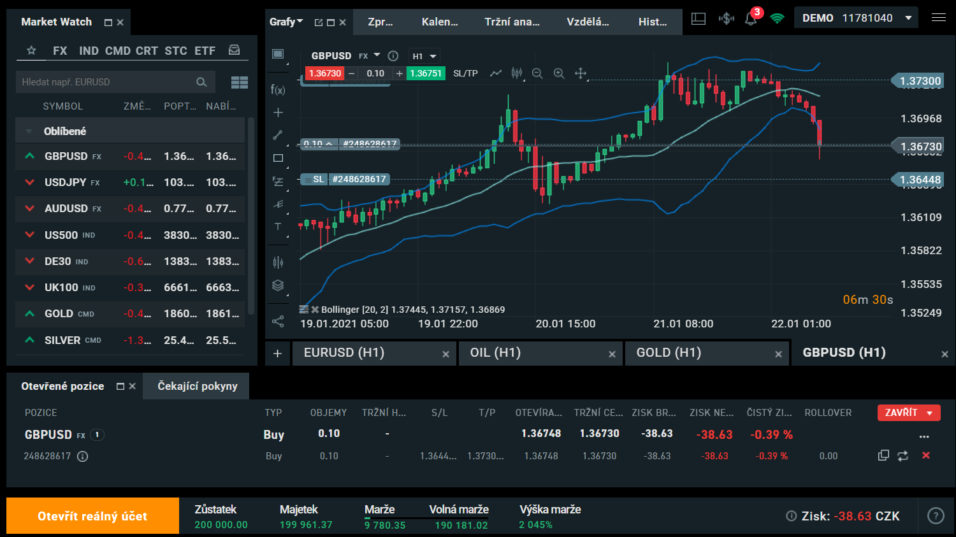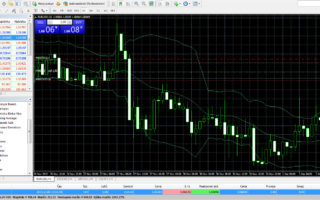The newest articles about forex:
-
 eToro stocks – up to 100 USD with promo code
eToro stocks – up to 100 USD with promo code -
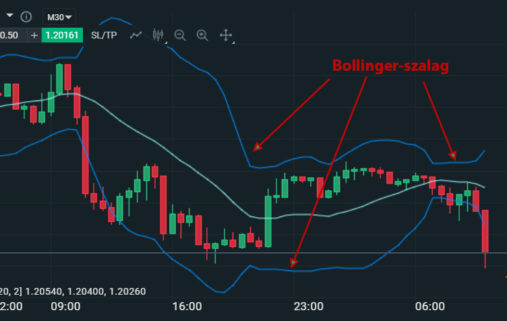 Tested Forex Strategy – Suitable for stocks and cryptocurrencies
Tested Forex Strategy – Suitable for stocks and cryptocurrencies
What is forex
Forex is a market with foreign currencies, the name is abbreviated from “foreign exchange“. The forex market currency trades account for 3 – 5 trillion US dollars daily. The currencies are traded by companies, governments and speculators.
Speculators make up for 80% of the total number of trades, they try to make a profit on the currency price movement. The forex market is open 24 hours a day, 5 days a week, there is no trading at the weekend.
Currency pairs
Currency pairs are the basis of every forex trade; from the very start, it is essential to know how they work.
A currency pair determines which value of the first currency corresponds to the value of the other currency. For instance, EUR/USD, USD/GBP. If EUR/USD has the value 1,21, it means that for 1 EUR, we can buy 1,21 USD. It is similar to when you exchange your money in an exchange office.
Most commonly traded currency pairs:
- EUR/USD
- USD/JPY
- GBP/USD
As you can see, the most traded currency pairs include the US dollar.
Where to trade currency pairs
Forex is traded on currency exchanges, the main ones are London, New York, Sydney and Tokyo. The London and New York currency exchanges are open 8 hours a day, the ones in Sydney and Tokyo for 9 hours. During workdays, at least one currency exchange is open.

You can trade at these exchanges only via intermediary companies, we call them brokers. A broker is a company which allows you to trade, it provides you with their trading platform. For using their services they charge fees, mostly in the form of spread (spread = the difference between the purchase and sale price). XTB and Plus500 are among the most popular brokers worldwide.
How to trade forex
The principle of trading is very simple. You trade one currency for another, intending to make a profit on the right forecast of the future price development.
Put simply, you buy one currency at the time you expect its price growth. On the contrary, you sell when you expect its price drop.
The price development is surely not random and can be forecasted with a certain probability. There are various strategies for the future price prediction, but we’ll get to this later. Now, let’s look at trading forex in practice.
Example of trading from practice
These pictures are from the XTB broker CFD trading platform. You can open a demo account within seconds 78% of retail investor accounts lose money when trading CFDs with this provider. , you just need to fill in your email, phone number and password and you can try out the trading platform with no commitments made.
In practice, you will need to follow certain rules on when to enter a trade, but I don’t want to overwhelm you with this right now. The point of this example is to show how to open and close a trade.
1. You set up the indicators which will help determine when to enter a trade
Indicators are mathematical calculations drawn in a chart. Right now, it is not important how they are calculated and what all features they have. It is essential to know that they help traders analyse market behaviour based on historical data.
Interesting fact: I used the Bollinger Bands indicator in the following example. When using Bollinger Bands, it is good to know that the exchange rate remains within the set band for the 95% of the time; generally, we can say that we subsequently trade the deviation in the exchange rate from the upper or lower band.
2. You decide to open the trade based on the previously selected signal
If the exchange rate enters the Bollinger Bands, it can be a signal, in general, the price change is then traded.
- If you predict that the exchange rate will fall, you sell (you click the “SELL” button).
- If you predict that the exchange rate will rise, you buy (you click the “BUY” button).
In the picture below, I am opening a trade (“BUY”), therefore, I am predicting the exchange rate to rise.
3. You set the limits to close the trade
The trades can be closed manually or you can set up an automatic trade closure when reaching a certain price level.
In the example trade, I set limits for closing the trade at the rates of 1.36421 and 1.37300. In the case the price enters or leaves these values, the trade will be closed.
If the price enters the 1.37300 value, the trade will be profitable. On the contrary, if it enters the 1.36421 value, it will be unprofitable. These levels can be changed as required before the closure of the trade. In this example, I chose the Take Profit levels within the band of the Bollinger Bands indicator because the exchange rate stays there 95% of the time and it is likely it will remain in this band. I set up the Stop Loss level slightly out of the Bollinger Bands. Of course, there are occasional unexpected price fluctuations which nobody can predict.
After opening the trade
As you can see in the picture above, immediately after opening, the trade is slightly unprofitable; you do not have to fear, nobody is stealing from you, it is an entirely common occurrence since the market is created by two prices – demand and offer. The difference between these prices is called a spread. A spread also includes the broker fee, it is, therefore, important to choose a broker with low spreads. High spreads lower your profit and may also increase your losses.
The trade results
Here I could show you a print screen from the trading platform to show you how profitable the trade is and how much money I have earned since I started writing this text. However, I am not going to do this because the result of a single trade is irrelevant information. The important thing is to be long-term profitable and to adhere to your trading strategy, including money management.
How do I determine whether the price will rise or fall?
The future price can be predicted with a certain probability. If it wasn’t possible, there wouldn’t be tens of thousands of successful forex traders in the world. The future price can never be 100% correctly forecasted, however, it is important to be profitable in the long run.
The price development depends on various factors such as GDP, unemployment, inflation, the interest rate in countries where the currency is normally used, etc. It is up to you if you consider these details in your trading, you can also trade only using historical data such as I did in the above example trade.
A trading strategy is used to determine the actual future price, more details on this topic are discussed in our tested forex strategy.
How much can I earn and how risky is it?
The amount of money you can earn is limited only by your skills. Successful traders have very above-average incomes.
You can find traders who have earned billions of dollars trading forex, which is, of course, an exception but it is great to be inspired by successful traders such as George Soros, Bill Lipschutz, Stanley Druckenmiller, etc.
Trading carries a certain risk, that’s why you should never trade money you are not willing to lose. The risk can be minimised by adhering to money management and by testing new strategies in the demo account.
What does CFD stand for?
 CFD is an abbreviation for a contract for difference. It is a deal between the broker and the trader based on which you may speculate on the development of trading assets. A trading asset can be a currency pair (forex), cryptocurrencies, indices, shares and commodities. You do not own the assets physically, but you are trying to correctly predict the future development of the rate and to profit on this. You can read more detailed information about this topic in our article What is a contract for difference and who is a CFD broker?
CFD is an abbreviation for a contract for difference. It is a deal between the broker and the trader based on which you may speculate on the development of trading assets. A trading asset can be a currency pair (forex), cryptocurrencies, indices, shares and commodities. You do not own the assets physically, but you are trying to correctly predict the future development of the rate and to profit on this. You can read more detailed information about this topic in our article What is a contract for difference and who is a CFD broker?
Basic forex terms – good to know
1. Leverage (leverage effect)
Forex is traded using so-called leverage. Leverage allows you to trade large volumes of money without having to own them. The leverage amount is set by the broker with a ratio such as 1:10. It means that for your every unit you will have 10 units at your disposal. The remaining units will be lent to you by the broker. Financial leverage increases your profits as well as potential losses.
Practice example*
Your leverage is set to 1:100, you are trading the EUR/USD currency pair and you want to buy 100 000 EUR for dollars. If you traded without using the leverage, according to the current exchange rate, you would need to have 106 160 USD (100 000 * exchange rate) on your trading account to buy 100 000 EUR. Using 1:100 leverage, you will need to have “only” 1 061,60 USD in order to execute the trade.
You find a suitable entry point to the trade, you buy, let’s say, 100 000 EUR for dollars with the 1.0616 exchange rate and you sell it back for 1.0626. Therefore, you earn (1.0626 – 1.0616) * 100 000 = 0.0010 * 100 000 = 100 USD.
You can also trade smaller volumes of money, so you don’t need to worry about risking too much in one trade. Most brokers will allow you to trade so-called micro lots, meaning 1000 units. When using the 1:100 leverage, 1000 units are only 10. By doing this, your potential losses will lower, but also your profits.
* The leverage amount can be limited by a regulation in the respective country, for example, in the EU, the maximal leverage for the main currency pairs is limited to 1:30.
2. Lots
A lot is a standardised unit for forex trading. As you may already know, leverage is used when forex trading. This allows you to trade much larger volumes of money such as 1 lot.
1 lot = 100 000 units of the base currency
Lots can be further divided, see the table.
| Lot Size | Definition | Equivalent in USD (your account currency) |
| 1 | Standard lot | 100 000 |
| 0.1 | Mini lot | 10 000 |
| 0.01 | Micro lot | 1 000 |
Practical use example:
If you bought 1 lot in the EUR/USD currency pair without leverage, it would cost you 100 000 * exchange rate, e.g.: 100 000 * 1.126 92 = 112 692 USD.
Using leverage 1:200*, 1 lot will cost you 100 000 * exchange rate/ leverage amount, e.g..: 100 000 * 1.126 92 / 200 = 563,46 USD and 1 micro lot will be 5,646 USD.
If your trade takes 2 days, the average movement in the EUR/USD currency pair is 70 pips. With buying 1 lot, on average, you can earn/lose 100 000 * 0,0070 = 700 USD, 70 USD at mini lots and 7 USD at micro lots.
* The leverage amount can be limited by a regulation in the respective country, for example, in the EU, the maximal leverage for the main currency pairs is limited to 1:30.
3. Pips
Pips are units with a decimal comma. If the EUR/USD exchange rate is 1.0626, it has in total 0626 pips, the zero is removed and we get the number 626. Pip values are used mainly for evaluating the trade, you may say: “In this trade, I have earned 20 pips.” This means that the difference between the purchase and sale price was 0,0020. If you buy 1 lot and earn 20 pips, you will earn 0,002 * 100 000 = 200 USD.
Pips in the currency pairs having the Japanese Yen are calculated differently, but this is not important for us at the moment.
4. Spread
A spread is a difference between the purchase and sale price of the currency. For example, if the EUR/USD currency pair has the purchase price (BUY) 1.0632 and the sale price (SELL) 1.0631, the difference between the prices is 1.0632 – 1.0631 = 0.0001 = 1 pip.
The spread size depends on the current offer and demand and also the broker’s settings. The broker artificially increases the spread as it is a way for them to earn money.
5. Stop loss, Take profit
Stop loss (SL) and Take profit (TP) are price limits.
If the price enters Stop loss, the trade is closed with a loss. If the price enters Take profit, the trade is closed with a profit.
The picture on the left shows the top red line as Stop loss and the bottom red line as Take profit.
6. Margin
A margin is a deposit blocked by a broker to cover potential trade losses. The margin amount depends on the leverage size and on the currency pair exchange rate you are trading.
Margin is calculated according to the formula ({Base currency} / {your account currency}) * exchange rate) / (leverage amount). However, it is unnecessary to know this formula, every trading platform calculates the margin amount on their own.
More details, including examples from practice, can be found here.
7. Indicators and patterns
Indicators and patterns help traders recognise when to enter a trade.
Indicators
Indicators are mathematical calculations plotted on a graph. Most indicators are dependent only on the previous price and time. However, there are also indicators which take into consideration the volume of trades. There is a wide range of indicators, the most common ones are Support and Resistance, Moving Averages, Bollinger Bands and Stochastic Oscillator.
Patterns
Patterns are formations plotted on a graph, they are often used as the last confirming signal to open a trade.
We operate our website in full transparency, we recommend reliable brokers with an excellent reputation and we honestly admit to you that we receive commissions for that from these brokers. You can find the mentioned brokers in the table below with a clickable link to their site. You don't pay anything extra, you get a reliable business partner and you help us keep the website up and running. Thank you.
| Broker | English | Min. deposit | Spread EUR/USD* | Platforms | License | |
|---|---|---|---|---|---|---|
| 100 USD | 1.0 pips Spread was taken 04.07.2025 at 11:12 from the web or trading platform of Etoro. | In-house built platform | FCAASICCySec | etoro.comreview EUR/USD*: 1.0 pips Spread was taken 04.07.2025 at 11:12 from the web or trading platform of Etoro. | ||
 | 0 | 0.9 pips Spread was taken 04.07.2025 at 11:12 from the web or trading platform of XTB. | In-house built platform | FCA CySec | xtb.comreview EUR/USD*: 0.9 pips Spread was taken 04.07.2025 at 11:12 from the web or trading platform of XTB. 78% of retail investor accounts lose money when trading CFDs with this provider | |
 | 100 USD | 0.8 pips Spread was taken 04.07.2025 at 11:12 from the web or trading platform of Plus500. | In-house built CFD platform | FCAASICCySec EFSA | plus500.comreview EUR/USD*: 0.8 pips Spread was taken 04.07.2025 at 11:12 from the web or trading platform of Plus500. 82% of retail investor accounts lose money when trading CFDs with this provider |
* The spread is variable for most brokers and changes depending on market volatility.
Between 74-89% of retail investor accounts lose money when trading CFDs. You should consider whether you can afford to take the high risk of losing your money.
